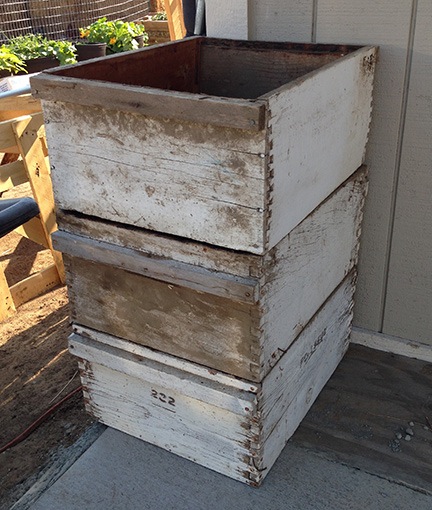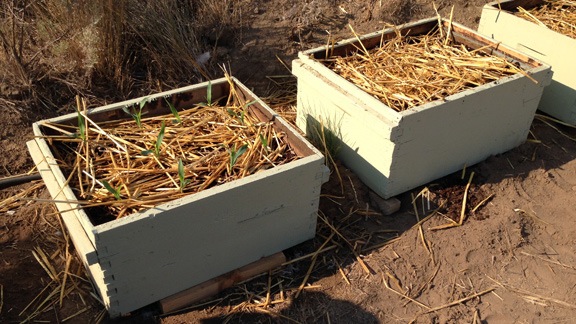Reuse, recycle.
A few months back, my beekeeping friend James told me he’d was able to get a bunch of used deep hive boxes for about $5 each. Knowing I used deep boxes — he uses only mediums — he offered them to me. I asked about the condition and he admitted that they were pretty beat up but could probably be usable with just a cleaning and fresh coat of paint. They were heavy-duty commercial boxes — the kind the migratory beekeepers use. I told him I’d take 10.

These hive boxes are a little more beat up than I was expecting them to be.
I picked them up a while later. Although structurally sound, they were very beat up. James showed me one that he’d painted and it didn’t look half bad. Since the price was right and I had plenty of paint, I took them.
I spent one morning scraping the paint off four of them with a wire brush and then repainting them. They did look much better. But when I slipped some frames into one of them, I realized that they weren’t consistently sized; the frames fit too loosely and would require careful placement to prevent them from falling into the box.

This is my garden hive, so-called because I placed it near my garden. It was built with two of the used boxes and it’s pretty clear that they simply don’t fit the way they need to.
But it wasn’t until I placed the first box of frames onto a hive bottom — for a swarm capture I needed to permanently house — that I realized the problem couldn’t be solved with just a coat of paint. The top and bottom edges of the boxes were rough. This caused gaps between the bottom and the box and between stacked boxes. The gaps were large enough for light and air to pass through. That meant the bees would be busy filling all those gaps with propolis, thus gluing them together.
I used the four I’d painted and found the same problem with all of them. Although I didn’t want to invest more money in beekeeping equipment than I had to, it was clear that these boxes would not be suitable for long-term use. They’d need to be replaced.
I placed an order for five new boxes from Mann Lake, figuring that I’d begin swapping them out on my next inspections.
But what to do with the unneeded boxes?
The answer was in my garden, which was growing wild in the planters I’d bought and made: more movable planters.
Understand that bee hive boxes do not have tops or bottoms. All they have are sides. While I could simply place a box on the ground, fill it with soil, and plant something in it, that wouldn’t make it movable. It also wouldn’t keep the moles (or voles or whatever I have making holes on my property) from digging in from underneath to kill whatever was growing in the box.
So I did the same thing I did for my large pallet planters — I lined the bottom with wire mesh. I had a large piece I’d been using on the door for my chicken yard that I clipped off, cut to size, and lay inside of each of the three boxes I painted for my trial run. I used a staple gun to fasten the wire to the sides of the boxes. Then I placed the first box in position, put a layer of stray on the bottom, right over the wire, and topped it off with some potting soil. I planted corn in the box, covered the soil with some more straw (to discourage digging by birds), watered it, and left it.
The corn wasn’t supposed to germinate for 8-10 days, but within 6 days, it was pushing its way up between the pieces of straw.

A row of the beehive planters. You can see the corn poking up through the straw in the closest box.
I lined up the other two boxes on the ground beside the first. I planted corn in one and onions in the other. When the heat breaks, I’ll prep the remaining three boxes, although I may not plant anything in them until next year.
What I like most about these movable planters is that they’re making it possible for me to have a garden this year, before I’m ready to commit to a location for the garden. And while the bottoms might not be the most sturdy, they do make it possible for plant roots to reach through, into the soil below.
I just hope I didn’t plant the corn too late for a good harvest.
Discover more from An Eclectic Mind
Subscribe to get the latest posts sent to your email.
Very clever, Maria!!! And they look nice as well.
Thanks, Shirley! They’ll look better when I have a more appropriate place for them, probably next year. I’m thinking of using them along the ground under my front deck, perhaps with some kind of climbing plant in them.
Love it, and I love seeing things like this. Our society desperately needs to get back to repurposing and caring more for our environment, that’s for sure. When people see things online like this, it helps spark imaginations and ideas.
But I know I’m speaking to the choir here. LOL
Oh — and they’d look great with some kind of climbing plant in them, too. So many possibilities!
I’ll definitely do a climbing plant. Perhaps peas and beans.